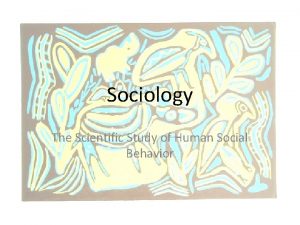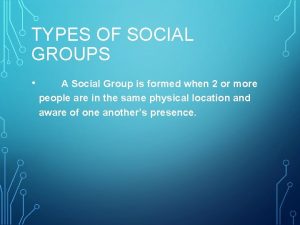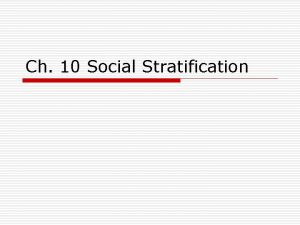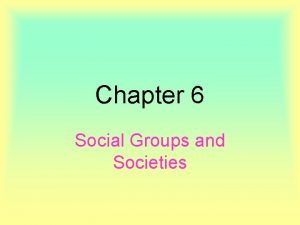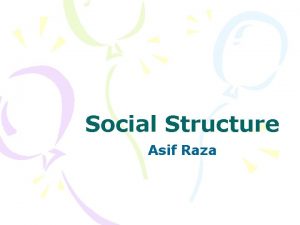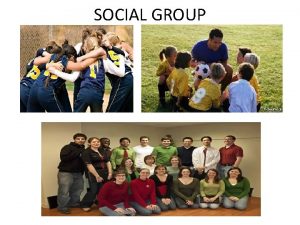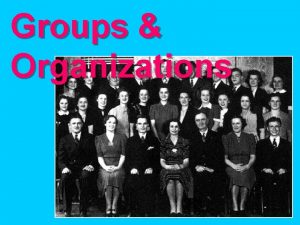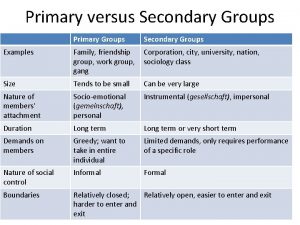CHAPTER FIVE SOCIAL STRUCTURE SOCIAL GROUPS AND SOCIAL
























- Slides: 24

CHAPTER FIVE SOCIAL STRUCTURE, SOCIAL GROUPS, AND SOCIAL ORGANIZATIONS Introduction to Sociology, 5/e © 2012 BVT Publishing

COMPONENTS OF SOCIAL STRUCTURE • The terms, status and role, are central to understanding social structure • A status is a socially defined position someone occupies – Status Set, Ascribed Status, Achieved Status, Master Status Introduction to Sociology, 5/e © 2012 BVT Publishing

COMPONENTS OF SOCIAL STRUCTURE (CONTINUED) • A role consists of the social expectations or behaviors associated with a particular status – Role Sets – Prescribed Role, Role Perception, Role Performance – Role Ambiguity, Role Strain, Role Conflict Introduction to Sociology, 5/e © 2012 BVT Publishing

TYPES OF SOCIAL INTERACTION • Generally, humans interact with intention • The five types of intentional social interaction are as follows: – Exchange – Cooperation – Competition – Conflict – Coercion Introduction to Sociology, 5/e © 2012 BVT Publishing

TYPES OF SOCIAL GROUPS • A group can be enormous, consisting of millions of people, or as small as two people • In sociology, there are many types of groups: – Non-social – In- and out– Limited social – Peer – Social – Reference – Primary and secondary Introduction to Sociology, 5/e © 2012 BVT Publishing

NON-SOCIAL GROUPS • Non-social groups are divided into statistical groups and categorical groups – Statistical groups are formed by sociologists and statisticians, not by the group members • For example, 10% of males in the U. S. between ages 16 and 24 have not graduated from high school – Categorical groups exist when a number of people share a common characteristic • For example, Hispanic Americans are U. S. citizens with ties to either Latin America or Spain Introduction to Sociology, 5/e © 2012 BVT Publishing

LIMITED SOCIAL GROUPS • Limited social groups interact minimally and members are more or less unconcerned with the feelings and attitudes of other members • Limited social groups are divided into aggregate groups and associational groups Introduction to Sociology, 5/e © 2012 BVT Publishing

LIMITED SOCIAL GROUPS (CONTINUED) – Aggregate groups consist people who are together in one place but socialize very little • For example, people riding on a bus together – Associational groups consist of people who join a large organization but rarely socialize • For example, members of the Sierra Club Introduction to Sociology, 5/e © 2012 BVT Publishing

SOCIAL GROUPS • Membership in a social group involves a) Some type of interaction b) A sense of belonging c) An organizational structure • The difference between a social group and an associational group is a matter of degree – e. g. , although the Sierra Club is an associational group, local chapters of the club are social groups Introduction to Sociology, 5/e © 2012 BVT Publishing

PRIMARY &SECONDARY GROUPS • Primary groups refers to small, informal groups of people who interact in a personal, direct, and intimate way – Your family close friends, and some neighbors are likely to be members of your primary group • Secondary groups refers to small or large formal groups of people who interact in a reserved, detached, and purposeful way – e. g. , committees, sports teams, college classes Introduction to Sociology, 5/e © 2012 BVT Publishing

IN-GROUPS AND OUT-GROUPS • In-groups consist of all the groups someone is a member of and feels a heightened sense of belonging and loyalty to – Can be small or large, but a strong sense of belonging and loyalty is what sets them apart • Out-groups consist of all the groups that someone is not a member of and feels little to no sense of belonging or loyalty to – Usually, we treat members of out-groups with indifference, but sometimes the interests of in- and out-groups clash Introduction to Sociology, 5/e © 2012 BVT Publishing

PEER GROUPS • Peer groups are informal primary groups whose member have similar statuses and ages • The unique factor in peer groups is inequality • That is, in peer groups, members are roughly equal in importance • While peer groups are usually associated with young people, they are found in all age groups Introduction to Sociology, 5/e © 2012 BVT Publishing

REFERENCE GROUPS • Reference groups are the groups we identify with psychologically and serve as the basis for self-evaluation • People need not belong to a group for it to be a reference group • For example, groups we aspire to belong to are reference groups • Groups we do not wish to join are also reference groups Introduction to Sociology, 5/e © 2012 BVT Publishing

RELATIVE DEPRIVATION • The concept of “reference group” underlies “relative deprivation. ” • The feeling of being deprived of something “relative” to one’s expectations. • Often a result of comparison to a reference group. • Examples? ? ? Introduction to Sociology, 5/e © 2012 BVT Publishing

GROUP SIZE • Dyads have two people; triads have three • Five major outcomes result from group size – Size has a dramatic effect on member interactions – As size increases, so does the division of labor – As size increases, so does the need formal leadership – As size increases, communication patterns change – As size increases, cohesion decreases Introduction to Sociology, 5/e © 2012 BVT Publishing

THE TWO TYPES OF SMALL GROUP LEADERS • Instrumental Leaders – Organize the group around its goals by suggesting ways to achieve them and persuading the members to act appropriately • Expressive Leaders – Resolve conflicts, create group harmony, and encourage social cohesion Introduction to Sociology, 5/e © 2012 BVT Publishing

SOCIAL NETWORKS • Social networks consist of the linkages or ties a person has to a set of relationships • Strong Ties – Strong ties are characterized by close interpersonal relations and are sustained by frequent calls, visits, emails, etc. • Weak Ties – Weak ties are characterized by impersonal relations where people have occasional contact Introduction to Sociology, 5/e © 2012 BVT Publishing

FORMAL ORGANIZATIONS • A formal organization is a large social group deliberately constructed and organized to achieve some specific and clearly stated goals • Formal organizations create levels or authority and channels of command that clarify who gives orders, who obeys orders, and who does what type of work in the organization Introduction to Sociology, 5/e © 2012 BVT Publishing

FORMAL ORGANIZATIONS (CONTINUED) • Sometimes the goals of different formal organizations can conflict Introduction to Sociology, 5/e © 2012 BVT Publishing

BUREAUCRACY • A bureaucracy is a formal organization that directs and coordinates the efforts of the people involved in various organizational tasks • The classical work on bureaucracy was written by Max Weber (1864– 1920) Introduction to Sociology, 5/e © 2012 BVT Publishing

BUREAUCRACY (CONTINUED) • According to Weber, bureaucracies have six major characteristics – Division of Labor and Specialization – Hierarchy of Authority – Impersonality – Qualifications – Career Pattern – Written Rules Introduction to Sociology, 5/e © 2012 BVT Publishing

DYSFUNCTIONS OF BUREAUCRACY • Sociologists have identified three major dysfunctions of bureaucracies: – Trained Incapacity: a situation where workers in bureaucracies robotically follow rules and regulations – Credentialism: the practice of basing hiring and promotions on rigid sets of formal qualifications – The Runaround: a situation where a problem cannot be solved because it does not fit neatly into one of the divisions of the bureaucracy Introduction to Sociology, 5/e © 2012 BVT Publishing

VOLUNTARY ASSOCIATIONS • People join voluntary associations out of personal interest • In voluntary associations, people enjoy socially interacting with other members because of their common focus of attention and shared goals Introduction to Sociology, 5/e © 2012 BVT Publishing

VOLUNTARY ASSOCIATIONS (CONTINUED) • People who earn similar amounts of money tend to join the same voluntary associations • Wealthy middle-aged people join voluntary associations the most Introduction to Sociology, 5/e © 2012 BVT Publishing
 How are ethnic groups and religious groups related
How are ethnic groups and religious groups related Basic four food groups 1956
Basic four food groups 1956 Vertebrates are classified as
Vertebrates are classified as Anamalia examples
Anamalia examples Five groups
Five groups 5 senses and 5 elements
5 senses and 5 elements Groups of cells with a common structure and function.
Groups of cells with a common structure and function. Groups of cells that are similar in structure and function
Groups of cells that are similar in structure and function And all its aching joys are now no more
And all its aching joys are now no more Five of five
Five of five The devil damn thee black
The devil damn thee black Behavior that matches group expectations
Behavior that matches group expectations India baby tossing
India baby tossing Social groups and formal organizations
Social groups and formal organizations Structures are laid-back and undefined.
Structures are laid-back and undefined. Different types of social groups
Different types of social groups Different types of social groups
Different types of social groups Classification of social group
Classification of social group Different types of social groups
Different types of social groups The hierarchical arrangement of large social groups
The hierarchical arrangement of large social groups Beureaucratic
Beureaucratic Interest groups vs social movements
Interest groups vs social movements Reciprocal model of social group work
Reciprocal model of social group work Classification of primary group
Classification of primary group Group of people
Group of people












